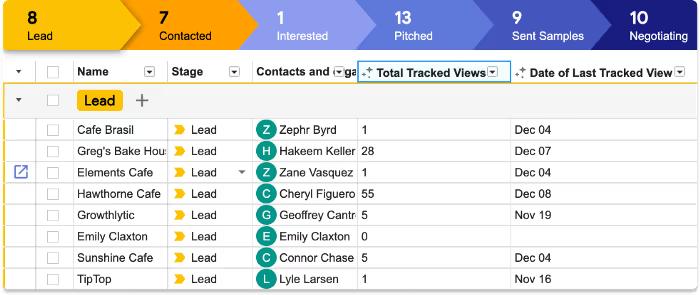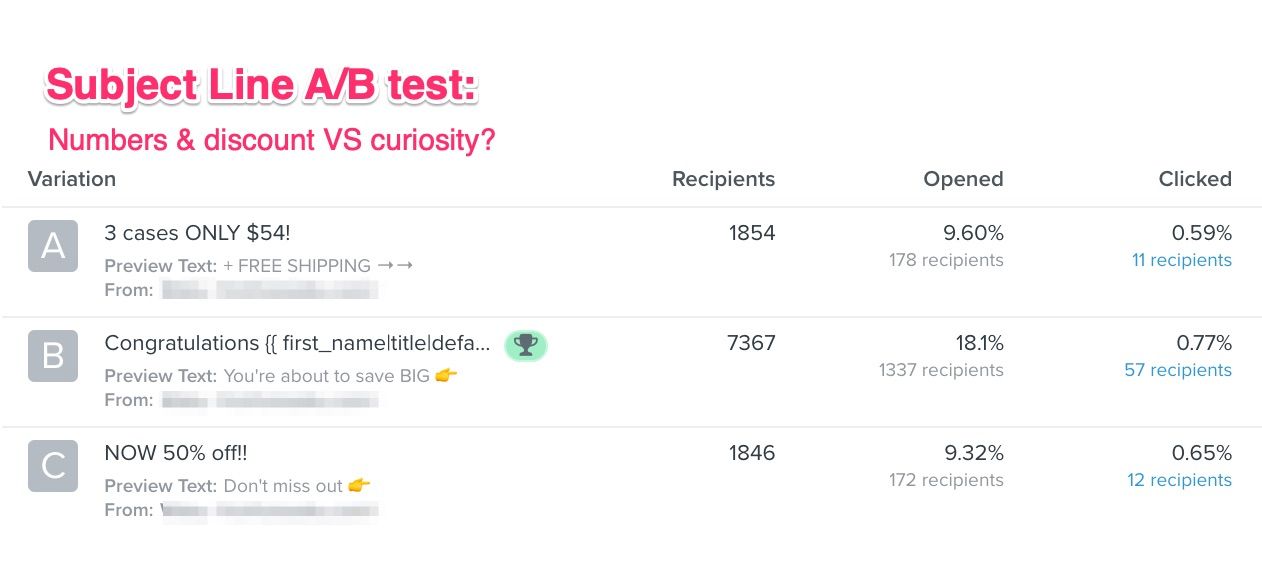Opening now...
Why do email tracking and analytics matter for your email outreach?
Email tracking and analytics can help you improve your email outreach across multiple business processes. Whether you’re reaching out to sales leads, raising funds for your startup or nonprofit organization, or hiring for a growing team, using a data-driven approach can help improve your outcomes.
Email tracking tools give you the “who, when, how” of your email outreach:
- Who: Which recipients are engaging with your message?
- When: When are they engaging with your emails?
- How: What are your contacts saying, and how can it improve your process?
By asking these questions, email tracking gives you insights into which subject lines increase open rates, which contacts have lost interest, and which CTAs are most effective – but that’s just the tip of the iceberg.
Here’s a quick list of the benefits of email tracking tools:
- <a href="#eliminate-guesswork" class="anchor-link">Eliminate guesswork and gut feelings</a>
- <a href="#improve-open" class="anchor-link">Improve open rate and read metrics</a>
- <a href="#fine-tune" class="anchor-link">Fine-tune email copy and CTAs</a>
- <a href="#manage-leads" class="anchor-link">Manage your leads more effectively</a>
- <a href="#deliver-higher" class="anchor-link">Deliver higher ROI on email campaigns</a>
Let’s get into it.
<div class="anchor-wrapper"><div id="eliminate-guesswork" class="anchor-target"></div></div>
1. Eliminate guesswork and gut feelings
“Should I follow up? It’s been three days, and I read somewhere that you’re supposed to wait two days before responding. But this source says to wait two weeks, and this one says one month…”
Knowing exactly when a lead engages with an email will lead to strategic and confident decision-making, increasing your email outreach efficacy and efficiency.
Let’s say you send out a cold email sequence and use an email tracking tool. Within one day, you start getting notifications telling you that your emails have been opened.
So you know that you have email activity, and it feels validating. But how does this feature help you with sales?
An email tracking tool can help you:
- Identify which recipients opened your email – and when they opened it
- Gain visibility into metrics such as open rate and click-through rate
Tools like Streak allow you to view your email tracking data right in your sales pipeline so you can filter, sort, and group your leads based on their email engagement. You’ll quickly be able to see who read your email multiple times… and who didn’t bother to open your message.

Knowing this information enables you to perfect your email marketing campaign without guessing.
Instead, you have hard numbers to help you make decisions such as:
- When you should send out emails (say, when your open rates are highest)
- Which people to send follow-up emails to and what type of follow-up email to send (for example, send a “Hey, in case you missed my previous email” follow-up to someone who hasn’t opened your initial message)
- Which leads are engaged and qualified
- Which leads are not worth following up on (e.g., those who have not opened any of your emails)
<div class="anchor-wrapper"><div id="improve-open" class="anchor-target"></div></div>
2. Improve email open rates and read metrics
Sending a message out into the unknown with no way to track it won’t give you any solid information on how it performed. For all you know, you might be repeating a sales process that isn’t working at all. That’s a huge waste of time and effort!
Email tracking tools allow you to monitor metrics to refine your marketing strategy with data-driven decisions.
You can do this easily with A/B testing. Sending out multiple variations of your mass email outreach allows you to test more email structures simultaneously.
Here’s what this improved email strategy might look like:
- A/B test different subject lines
- Measure the open rate and engagement metrics
- Repeat and scale versions of the emails that are proven to be effective
- Continue to make improvements on the winning version of your email
- Repeat
The most important factor in boosting open rates is your subject line, and A/B testing is your secret weapon to building the perfect one.
Let’s take a look at someone who’s used A/B testing to improve their subject line and open rates like a pro.
Kasey Luck, the founder of Luck & Co, put her email marketing campaign through extensive A/B testing and tracking to find the ideal subject line.
She was surprised to find out that her original tactic (putting a number in the subject line, e.g., 50% off) wasn’t as great as she thought.

The two subject lines with numbers had open rates of 9.6% and 9.3%. Subject line B relied on intrigue instead and crushed them both with an open rate of 18.1%.
Relying on customer curiosity – and not numbers and percentages – led to an increase in click rates by 30.5% and an increase in open rates by 88.5%.
Now Kasey can move forward with the subject line that’s proven to work, increasing her reach and the campaign’s effectiveness.
Continuous improvement is just one of the great side effects of email tracking.
<div class="anchor-wrapper"><div id="fine-tune" class="anchor-target"></div></div>
3. Fine-tune email copy and CTAs
Examining which emails were opened, read, and responded to will help you perfect your email copy.
Take a look at these opened emails. See if they have anything in common, such as:
- They all used similar subject lines
- They all agitated the same pain point
- They all had under 100 words
If your marketing emails direct leads towards a sales or donation page, you can also measure your open rates versus your click-through rate. This will give you great insights into the effectiveness of your calls to action.
Let’s take this optimization a step further by studying the responses you receive.
What questions did your prospects ask? Were they confused about your offering? Did they imply that the tone wasn’t quite right?
You can use prospect responses to clarify your email copy and sharpen your unique selling proposition (USP). You can even create email templates with the most effective copy to save time.
Improving your email marketing campaigns is a constant experiment to find the perfect tone, wording, layout, and formatting. Email tracking tools simplify this process to something manageable and visible so you can maximize the outcome of each email campaign.
<div class="anchor-wrapper"><div id="manage-leads" class="anchor-target"></div></div>
4. Manage your leads more effectively
Tracking email engagement among your sales, hiring, or fundraising leads allows you to double down on leads who are interested in your messages, and move on from those who aren’t. The key is to incorporate email tracking data into your lead tracking tool or CRM.
Email tracking tools in your CRM allow you to:
- Add email tracking data to sales, fundraising, and other pipelines
- Organize your leads by email engagement
- Gain quick access to all the emails and notes associated with a certain prospect
- Automatically update leads with new information, such as the last tracked view
- Schedule follow-up emails effectively
If your email tracking data isn’t connected to your sales, fundraising, or hiring process, it’s hard to use the data to close more deals, get through to investors and donors, or bring on new candidates. Incorporating this data right into your pipelines means you can start acting on new data as soon as you reach out to your leads.
<div class="anchor-wrapper"><div id="deliver-higher" class="anchor-target"></div></div>
5. Deliver higher ROI on email campaigns
Email tracking tools improve efficacy, reduce opportunity costs, and maximize the email campaign's potential profit.
Tracking your emails boosts ROI in two main ways:
- Maximizing the deals closed from your email campaigns
- Maximizing efficiency so that you can spend your time on other profitable activities
Let’s look at a simple comparison – say a fundraising manager is looking to raise funds without the aid of an email tracking software or app.
They’ve got a CRM full of potential prospects and a good idea of what they want to say, but they don’t have a clear structure of how and when to send their message or any way to measure success.
The manager sends out 200 emails and gets some replies, but they don’t know what works and what doesn’t. Trying to figure this out costs precious time that they could be using on other donation-raising activities… but not using the data means you’re unable to improve your email fundraising efforts in a deliberate manner.
Okay, so how about the same fundraising manager with email tracking tools?
At a glance, the manager can see, “Out of 200 messages, I got 20 replies and 90 opens.”
They can compare this to previous email campaigns and clearly see when an email sequence works. If the open rate is lower than normal? Change the subject line, A/B test it, and send the winning variation in future emails.
Our fundraising manager is not only seeing an improved email campaign and boosted donations, but they’re also able to spend their time on other profitable, positive activities.
Start tracking your emails
Email tracking tools can be a massive game changer for your email outreach campaigns.
You can make data-driven decisions that boost your email outreach strategy significantly when you have visibility into email metrics.
Knowing what works and what needs work are key components to fine-tuning your campaign’s efficiency and saving yourself valuable time, leading to more leads and better ROI.
Email tracking doesn’t just give you a warm fuzzy feeling when your email is opened, it’s a crucial part of your tech stack.
Subscribe to our blog
Stay in the loop with Streak’s latest features and insights.
Related articles
No items found.



.webp)


